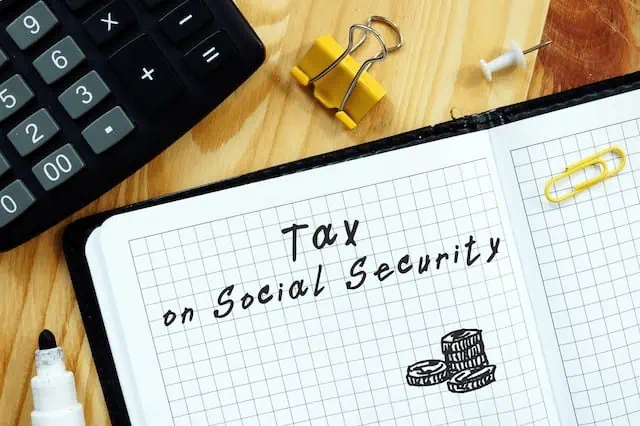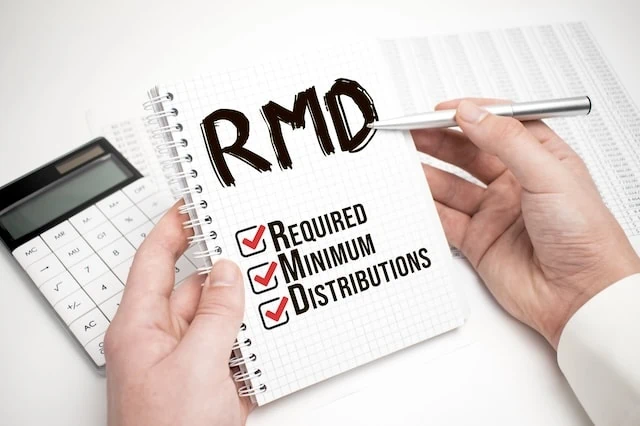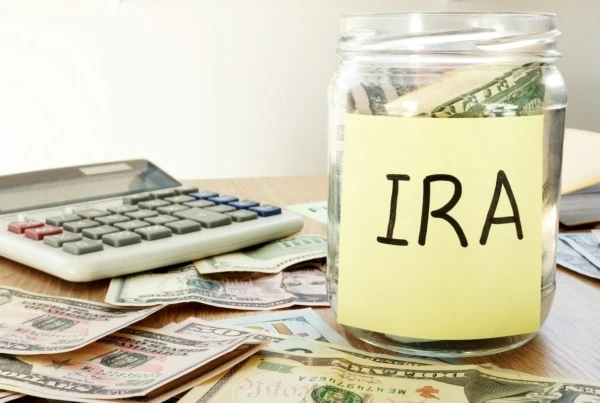You don’t stop paying taxes once you retire, but your tax situation does shift considerably.
And this turbulence leads to a wide number of retirement tax myths.
You see, many myths (about anything, not just taxes!) don’t just appear out of nowhere—they’re often bred from either misunderstandings about a subject, or changes that happen within that subject over time.
Today, I’m going to dispel a number of common retirement tax myths. And if you previously believed any of these myths, don’t feel bad—it’s very likely they are or were grounded in reality at some point.
Popular Misconceptions About Taxes in Retirement

I’ll be blunt: Retirement taxes are complicated and confuse a good chunk of Americans.
The Northwestern Mutual 2024 Planning & Progress Study asked Americans whether they agreed with the statement “I have a good understanding of how taxes could impact my retirement and have factored that into my financial plans.”
More than half (54%) of Gen Xers disagreed with that statement. So did 42% of baby boomers.
In other words: If you’re confused about how taxes work when you’re retired, you’re not alone.
Of course, the only thing worse than having no information about a subject is having inaccurate information—and when it comes to retirement taxes, there are a number of oft-repeated myths. Today, though, I’m going to put those myths to bed.
Do you want to get serious about saving and planning for retirement? Sign up for Retire With Riley, Young and the Invested’s free retirement planning newsletter.
Myth #1: Everyone Is in a Lower Tax Bracket in Retirement

The truth: Most people have a lower tax rate during retirement than they do during their prime earnings years—but not all people.
The generality itself makes sense. Your retirement income is typically less than your working-age income, which alone should put you in a lower bracket. Only part of your Social Security benefits are taxed at the federal level, and most states don’t tax them at all. Also, you’re no longer on the hook for payroll taxes.
However, there are exceptions.
If you have a retirement account with a very high balance that was funded with pre-tax dollars, once your required minimum distributions (RMDs) kick in at age 73, those RMDs might send you into a higher tax bracket than where you were before retirement. Or even before your RMDs begin, you might take a large withdrawal one year to treat yourself during retirement, and that could put you over the hump. You could also have additional sources of income in retirement that you didn’t have during your working years.
Again, most people will be in a lower tax bracket … but because it’s not a sure thing, you’ll want to crunch the numbers yourself (or have a financial advisor do the crunching) so you can more accurately estimate your tax burden and plan accordingly.
Related: Federal Tax Brackets and Rates
Myth #2: Social Security Benefits Are Never Taxed

OK, I already spoiled this one, but yes—despite what you might have heard, some people’s Social Security benefits are indeed taxed. Specifically, the Social Security Administration (SSA) says that between 2015 and 2050, some 56% of beneficiary families will owe federal income tax on part of their benefits.
You can look at our article on how Social Security benefits are taxed for a longer explanation, but in short: To determine whether you’ll be taxed on your Social Security benefits (and if so, how much you’ll pay), you start by figuring out your provisional income, also known as combined income. Provisional income generally is considered to be the combined total of 50% of your Social Security benefits, modified adjusted gross income (MAGI), and tax-exempt interest. If you’re filing a joint return, include amounts for both spouses.
Here’s a look at who should expect to pay federal tax on Social Security benefits, and how much, based on filing status:
| Filing Status | Provisional Income | Percent of Benefits Taxable |
|---|---|---|
| Single, Head of Household, Surviving Spouse, Married Filing Separately (lived apart for entire year) | $0 to $25,000 | 0% |
| $25,001 to $34,000 | Up to 50% | |
| $34,001 or more | Up to 85% | |
| Married Filing Jointly | $0 to $32,000 | 0% |
| $32,001 to $44,000 | Up to 50% | |
| $44,001 or more | Up to 85% | |
| Married Filing Separately (lived together for part of year) | $1 or more | Up to 85% |
Whether or not you pay taxes on your Social Security benefit at the state level depends on where you live. Although most states don’t, there are still some states that tax Social Security benefits.
Related: What Are Social Security Spousal Benefits [And How Do They Work?]
Myth #3: 401(k) Rollovers Aren’t Taxed

When you retire, you might choose to withdraw cash or assets from a qualifying retirement account and move all or part of it to a different eligible retirement account (aka a “rollover”).
A common reason investors perform rollovers is because they provide more control over how funds are invested. Most 401(k) plans have limited investment choices—between 10 and a couple dozen mutual funds. However, if you roll your 401(k) into another account, such as an individual retirement account (IRA), you’ll generally have far more investment options—individual stocks, individual bonds, exchange-traded funds (ETFs), and a much larger number of mutual funds, among others. Also, IRAs typically will have lower fees (if any) than a 401(k).
Rollovers generally aren’t taxed, but there are exceptions.
With a direct rollover, the 401(k) plan administrator forwards your money directly to the IRA provider institution, either electronically or via a check made payable to the IRA provider. No taxes are withheld with a direct rollover.
With an indirect rollover, your 401(k) plan administrator will send you a check made payable to you … with 20% withheld for income taxes. However, you still must deposit the full amount withdrawn from the 401(k) plan into an IRA to avoid taxes and penalties. As a result, you’ll have to come up with that 20% out of your own pocket for the deposit.
The good news? This tax is temporary—you’ll receive it back later when you file your tax return for that year.
However, if you roll a traditional 401(k) over into a Roth IRA or another type of Roth account, this transaction—called a Roth conversion—will be taxable, as you’re moving money from a plan that must be funded with pretax dollars to a plan that must be funded with after-tax dollars. In fact, you generally will have to pay those taxes before you file your annual tax return, in the form of quarterly estimated taxes.
Related: 5 Costly 401(k) Rollover Mistakes You Must Avoid
Myth #4: All Pension Payments Are Taxed

Pensions are less popular than they once were, but there are still many jobs with pensions. And if you have one of those jobs, good for you—pensions are great!
Alas, they’re virtually always subject to federal income taxes, as they’re virtually always funded with pretax dollars.
However, you might avoid taxes on part of your pension payments. If you make after-tax contributions to a pension, you won’t be taxed on the portion of the pension payment that represents a return of the after-tax amount you paid.
You can also avoid state-level taxes on pension payments if you live in one of the following 15 states:
- Alabama
- Alaska (no income tax period)
- Florida (no income tax period)
- Hawaii (only tax-free if you didn’t make contributions to the plan; employee-contributed plans are partially taxable)
- Illinois
- Iowa (must be at least 55 years old by the end of the tax year; one spouse can qualify without the other qualifying)
- Mississippi (can’t be for early retirement)
- Nevada (no income tax period)
- New Hampshire
- Pennsylvania (can’t be for early retirement)
- South Dakota (no income tax period)
- Tennessee (no income tax period)
- Texas (no income tax period)
- Washington (no income tax period)
- Wyoming (no income tax period)
In short, you can expect to pay federal taxes on at least some if not all of your pension payments, but you might catch a break at the state level.
Related: What Is the Government Pension Offset [And How Does It Work?]
Myth #5: HSA Withdrawals Aren’t Taxed Once You Reach Age 65

Health savings accounts (HSAs) have a “triple tax benefit” in which contributions are pre-tax or tax-deductible, money grows tax-free within the account, and withdrawals are free of tax if the money is used for qualified medical expenses (QMEs). For that reason, many people use their HSA as a supplemental retirement account.
HSAs work like a 401(k) or IRA in that you’re penalized for using it before a certain age—if the money isn’t spent on QMEs. Specifically, if you’re younger than 65, and you use HSA money on non-qualified expenses, your withdrawal will be subject to both income taxes and a 20% penalty.
Some retirement savers errantly believe that once they reach age 65, they can withdraw at will with no tax consequences or penalties.
They’re partially right. When you’re 65 or older, you continue to benefit from tax- and penalty-free withdrawals for QMEs. However, if you use withdrawal funds for non-qualified expenses, you won’t face the 20% penalty but you’ll still owe income taxes.
By the way: If you leave your HSA to your spouse when you pass away, the rules function the same for them—but if you leave it to anyone who isn’t your spouse, that beneficiary must take the full disbursement and pay taxes on that full amount.
Related: 6 Common HSA Mistakes to Avoid
Myth #6: All Roth IRA Withdrawals Are Tax-Free in Retirement

If you have a Roth IRA, you can withdraw contributions whenever you’d like without triggering taxes or penalties. Your contributions were made with dollars that were already taxed, so they won’t be taxed again.
Earnings are a little more complicated.
If you’re younger than 59½ and your first contribution to your Roth IRA was less than five years ago, you’ll face taxes and a 10% penalty on withdrawals of earnings; if you’re younger than 59½ but your first contribution was at least five years ago, you’ll skip the penalty but still owe taxes. (Some exceptions apply in both cases.)
Once you reach 59½, however, you don’t pay taxes or penalties on withdrawals … unless your first contribution to the Roth IRA was less than five years ago.
Example: You open a Roth IRA and make your first contribution to it when you turn 58. You retire when you turn 62. You are past the 59½ age threshold, but your first contribution will only have been four years ago. Any withdrawals of earnings would be taxed until you turn 63.
This rule applies to inherited Roth IRAs, as well, with the five years starting when the original owner made the first contribution.
Related: Plan for These 7 Hidden Retirement Costs
Myth #7: All Traditional IRA Distributions Are Taxed

For the vast majority of practical purposes, this one is true—but philanthropists can use a loophole for the greater good.
Once you reach age 70½, you can make tax-free transfers of up to $100,000 annually from an IRA. These transfers are referred to as qualified charitable distributions (QCDs).
Distributions must be paid directly from the IRA and sent to an eligible charitable organization. You won’t qualify for the exemption if you take a withdrawal, then donate to a charity later from a regular bank account. However, you can make QCDs regardless of whether you itemize.
Another bonus? If you’re at least 73 years old, your QCDs can count toward your annual RMD.
If you already donate to charities, this is an extremely tax-efficient way to do so in retirement.
Related: What Is the Standard Deduction?
Myth #8: The Rule of 55 Lets You Withdraw From All of Your Retirement Accounts Penalty-Free

Some people can’t wait until age 59½ to retire, whether by choice or by circumstance. These retirees face a major hurdle in that most retirement accounts will apply a 10% penalty if they withdraw before reaching that age.
The Rule of 55 helps retirees avoid this obstacle.
You can read our full explanation of the Rule of 55, but in short, it allows you to start taking distributions from your 401(k) without the early withdrawal penalty if you have lost or left your job during or after the calendar year in which you turn 55. Taxes will still apply, of course, just like they would if you were age 59½ or older—you’re just dodging the penalty.
But the Rule of 55 isn’t a catch-all. It has several restrictions, including …
- It only applies to employer-sponsored retirement plans like 401(k)s and 403(b)s. It does not apply to IRAs and other personal plans.
- It only applies to the plan you were contributing to when you left that job. It does not apply to every workplace retirement account you own.
- You cannot roll your 401(k) funds over into an IRA. Penalties will begin to apply if you move your funds into an IRA.
However, you can continue using the Rule of 55 if you get another job.
Myth #9: Nobody Pays Medicare Taxes in Retirement

Retirees usually avoid paying Medicare taxes … but not always.
If you are a higher earner through investment income, you might owe the Net Investment Income Tax (NIIT), which is a supplemental Medicare tax.
Your investment income includes (but isn’t limited to) capital gains, dividends, interest, rental or royalty income, non-qualified annuities, and certain types of business income. The tax, which is charged at a 3.8% blanket rate as of 2025, applies to investment income for households that exceed a MAGI threshold for the year. In 2025, the thresholds are …
- Single or head of household (with qualifying person): $200,000
- Married filing separately: $125,000
- Married filing jointly: $250,000
- Qualifying widow/widower (with dependent child): $250,000
The tax only applies to the portion of your MAGI earned through investments, and it only applies to earnings that exceed the MAGI threshold.
In some situations, estates and trusts might also be subject to the NIIT.
Related: How Long Will My Savings Last in Retirement? 4 Withdrawal Strategies
Myth #10: All Retirement Accounts Have Required Minimum Distributions

Don’t feel too bad if you thought all retirement accounts had required minimum distributions. Most do.
Just not all.
Roth IRAs do not require RMDs. And as of 2024, neither do employer-sponsored Roth plans, thanks to the 2022 passage of the Secure 2.0 Act.
That said, if you inherit a Roth account, you might be subject to RMDs.
Spouses don’t have to take RMDs from an inherited Roth account. Instead, they can roll over the funds into their own Roth account and avoid RMDs completely.
Nonspousal beneficiaries of a Roth account must empty the account by the end of the 10th year following the year of the original owner’s death. So technically, they have RMDs—they’re required to distribute a minimum of the entire account balance within 10 years. But there’s no schedule mandating how often you must take distributions from the account.
Also, if the inherited account is at least five years old, distributions are tax-free.
Want to talk more about your financial goals or concerns? Our services include comprehensive financial planning, investment management, estate planning, taxes, and more! Schedule a call with Riley to discuss what you need, and what we can do for you.









